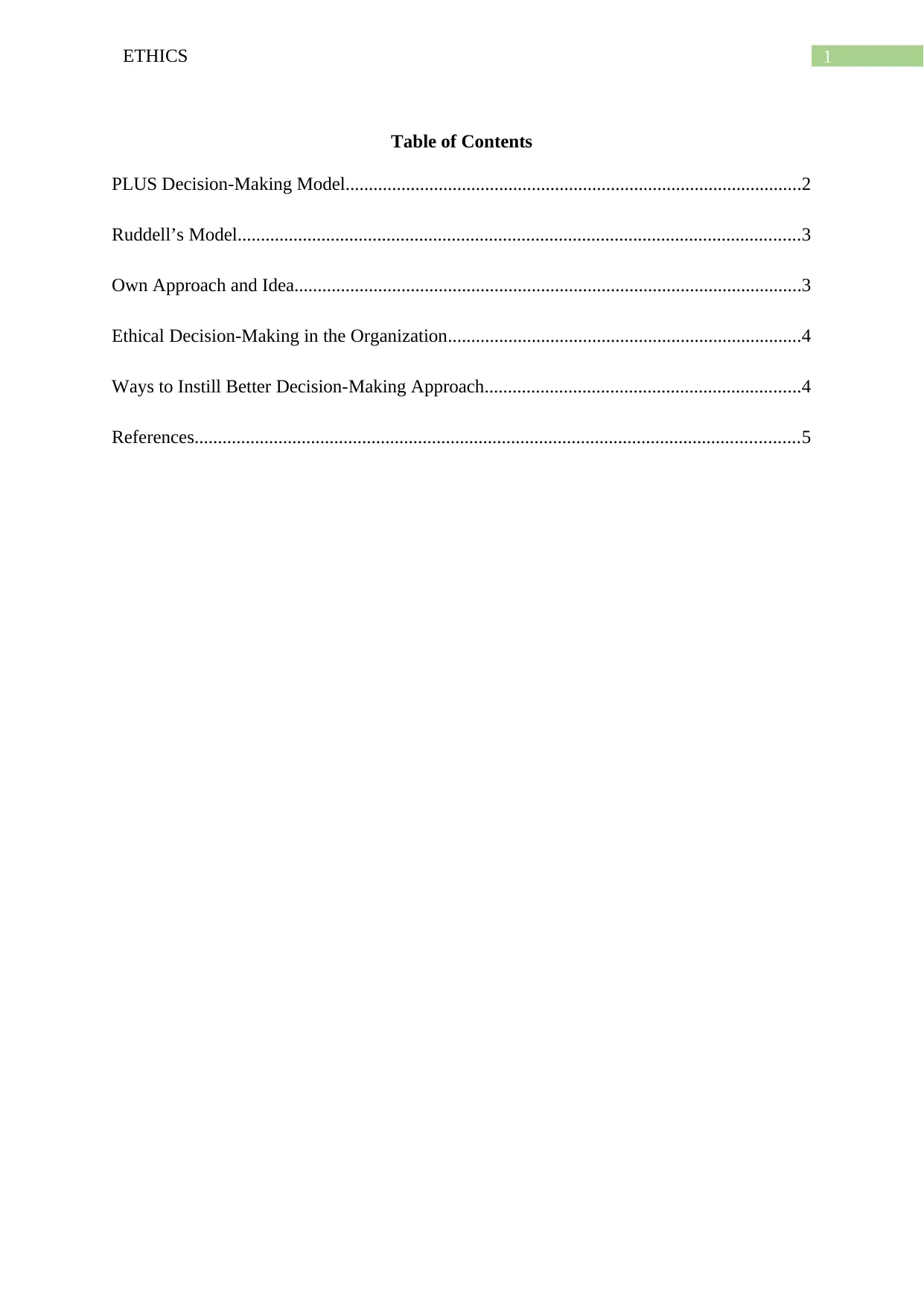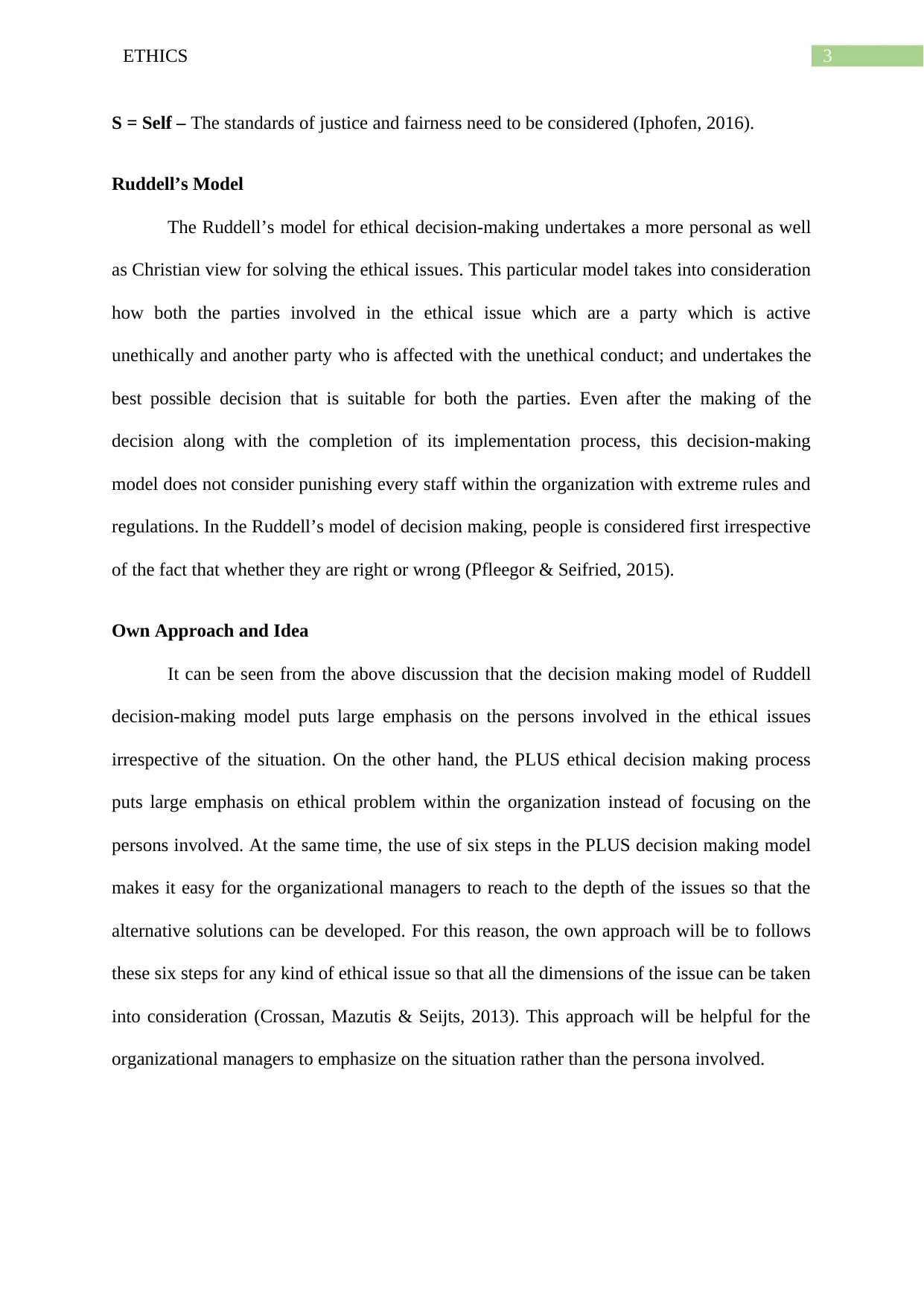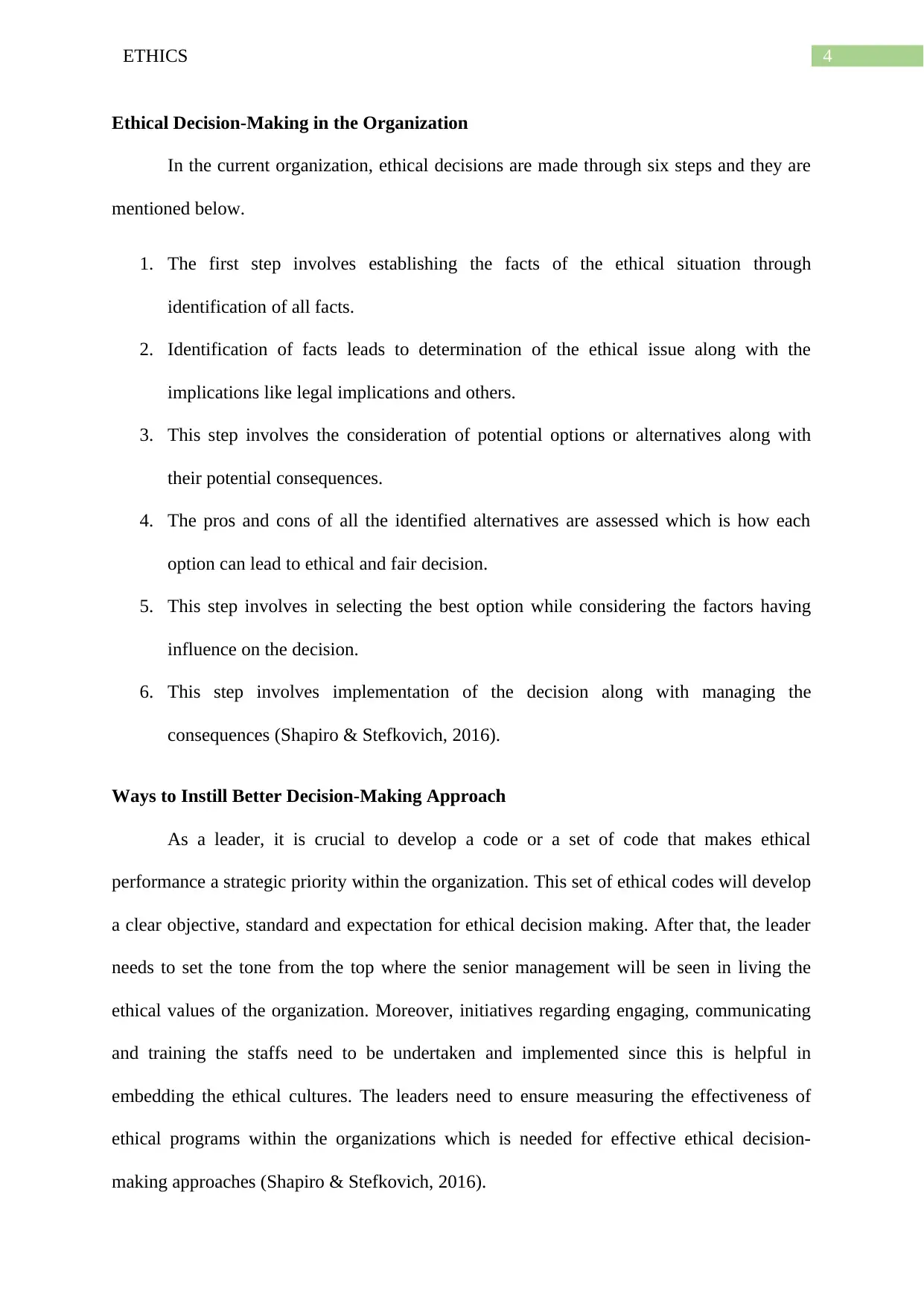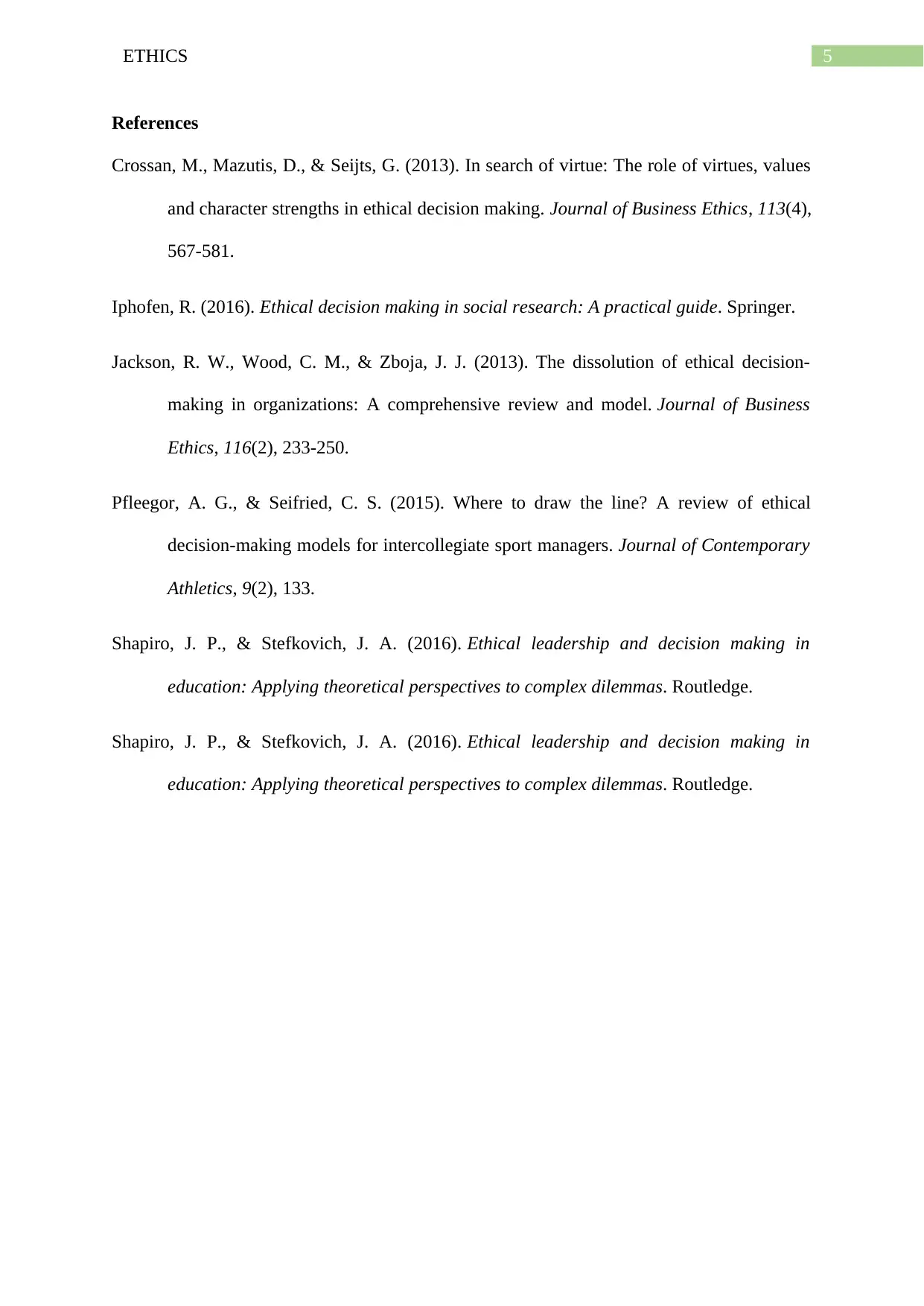Comparison of Ethical Decision-Making Models Report
VerifiedAdded on 2022/10/18
|6
|1159
|15
Report
AI Summary
This report delves into the realm of ethical decision-making within organizations, examining two prominent models: the PLUS model and Ruddell's model. The PLUS model, a structured approach, outlines six steps for addressing ethical issues, incorporating ethical filters like Policy, Legal, Universal, and Self. Conversely, Ruddell's model emphasizes a more personal, almost Christian perspective, prioritizing the individuals involved in ethical dilemmas. The report then presents a comparative analysis, highlighting the strengths and weaknesses of each model. The author proposes their own approach, emphasizing the six steps of the PLUS model to ensure a comprehensive evaluation of ethical issues. The report further discusses ethical decision-making in the context of organizations, outlining a six-step process and ways to instill a better decision-making approach. Finally, the report emphasizes the importance of establishing ethical codes, setting a tone from the top, and continuously evaluating the effectiveness of ethical programs within organizations to foster a culture of ethical leadership.

Running head: ETHICS
Ethics
Name of the Student
Name of the University
Author’s Note
Ethics
Name of the Student
Name of the University
Author’s Note
Paraphrase This Document
Need a fresh take? Get an instant paraphrase of this document with our AI Paraphraser

1ETHICS
Table of Contents
PLUS Decision-Making Model..................................................................................................2
Ruddell’s Model.........................................................................................................................3
Own Approach and Idea.............................................................................................................3
Ethical Decision-Making in the Organization............................................................................4
Ways to Instill Better Decision-Making Approach....................................................................4
References..................................................................................................................................5
Table of Contents
PLUS Decision-Making Model..................................................................................................2
Ruddell’s Model.........................................................................................................................3
Own Approach and Idea.............................................................................................................3
Ethical Decision-Making in the Organization............................................................................4
Ways to Instill Better Decision-Making Approach....................................................................4
References..................................................................................................................................5

2ETHICS
PLUS Decision-Making Model
This is considered as a major model in order to solve the ethical issues within the
business organizations. The presence of both the steps required for ethical decision-making
process and ethical filters can be seen within this model. The steps are discussed below:
Step 1: Definition of the Problem – It is required to get a clear understanding about the
problem and this is a crucial step to consider.
Step 2: Identification of the Alternatives – It is needed to identify at least five to three
alternatives that will help in solving the issue.
Step 3: Evaluation of Alternatives – This step involves the utilization of the fashioned
pros/cons list for the evaluation of the alternatives.
Step 4: Making the Decision – This step includes making the informed decision by paying
attention towards the timing.
Step 5: Implementation of the Decision – The undertaken decision needs to be
implemented through careful consideration while make the relevant parties known.
Step 6: Evaluation of the Decision – Determination of the appropriate measures for
measuring the success of the decision (Jackson, Wood & Zboja, 2013).
Apart from the above steps, this model recommends certain ethical filters as the key
points in the decision-making model; they are as below:
P = Policy – Managers are needed to take decisions while considering the organizational
policies.
L = Legal – Violation of any legal regulations need to be considered.
U = Universal – This considers the relation of the decision with the values and principles.
PLUS Decision-Making Model
This is considered as a major model in order to solve the ethical issues within the
business organizations. The presence of both the steps required for ethical decision-making
process and ethical filters can be seen within this model. The steps are discussed below:
Step 1: Definition of the Problem – It is required to get a clear understanding about the
problem and this is a crucial step to consider.
Step 2: Identification of the Alternatives – It is needed to identify at least five to three
alternatives that will help in solving the issue.
Step 3: Evaluation of Alternatives – This step involves the utilization of the fashioned
pros/cons list for the evaluation of the alternatives.
Step 4: Making the Decision – This step includes making the informed decision by paying
attention towards the timing.
Step 5: Implementation of the Decision – The undertaken decision needs to be
implemented through careful consideration while make the relevant parties known.
Step 6: Evaluation of the Decision – Determination of the appropriate measures for
measuring the success of the decision (Jackson, Wood & Zboja, 2013).
Apart from the above steps, this model recommends certain ethical filters as the key
points in the decision-making model; they are as below:
P = Policy – Managers are needed to take decisions while considering the organizational
policies.
L = Legal – Violation of any legal regulations need to be considered.
U = Universal – This considers the relation of the decision with the values and principles.
⊘ This is a preview!⊘
Do you want full access?
Subscribe today to unlock all pages.

Trusted by 1+ million students worldwide

3ETHICS
S = Self – The standards of justice and fairness need to be considered (Iphofen, 2016).
Ruddell’s Model
The Ruddell’s model for ethical decision-making undertakes a more personal as well
as Christian view for solving the ethical issues. This particular model takes into consideration
how both the parties involved in the ethical issue which are a party which is active
unethically and another party who is affected with the unethical conduct; and undertakes the
best possible decision that is suitable for both the parties. Even after the making of the
decision along with the completion of its implementation process, this decision-making
model does not consider punishing every staff within the organization with extreme rules and
regulations. In the Ruddell’s model of decision making, people is considered first irrespective
of the fact that whether they are right or wrong (Pfleegor & Seifried, 2015).
Own Approach and Idea
It can be seen from the above discussion that the decision making model of Ruddell
decision-making model puts large emphasis on the persons involved in the ethical issues
irrespective of the situation. On the other hand, the PLUS ethical decision making process
puts large emphasis on ethical problem within the organization instead of focusing on the
persons involved. At the same time, the use of six steps in the PLUS decision making model
makes it easy for the organizational managers to reach to the depth of the issues so that the
alternative solutions can be developed. For this reason, the own approach will be to follows
these six steps for any kind of ethical issue so that all the dimensions of the issue can be taken
into consideration (Crossan, Mazutis & Seijts, 2013). This approach will be helpful for the
organizational managers to emphasize on the situation rather than the persona involved.
S = Self – The standards of justice and fairness need to be considered (Iphofen, 2016).
Ruddell’s Model
The Ruddell’s model for ethical decision-making undertakes a more personal as well
as Christian view for solving the ethical issues. This particular model takes into consideration
how both the parties involved in the ethical issue which are a party which is active
unethically and another party who is affected with the unethical conduct; and undertakes the
best possible decision that is suitable for both the parties. Even after the making of the
decision along with the completion of its implementation process, this decision-making
model does not consider punishing every staff within the organization with extreme rules and
regulations. In the Ruddell’s model of decision making, people is considered first irrespective
of the fact that whether they are right or wrong (Pfleegor & Seifried, 2015).
Own Approach and Idea
It can be seen from the above discussion that the decision making model of Ruddell
decision-making model puts large emphasis on the persons involved in the ethical issues
irrespective of the situation. On the other hand, the PLUS ethical decision making process
puts large emphasis on ethical problem within the organization instead of focusing on the
persons involved. At the same time, the use of six steps in the PLUS decision making model
makes it easy for the organizational managers to reach to the depth of the issues so that the
alternative solutions can be developed. For this reason, the own approach will be to follows
these six steps for any kind of ethical issue so that all the dimensions of the issue can be taken
into consideration (Crossan, Mazutis & Seijts, 2013). This approach will be helpful for the
organizational managers to emphasize on the situation rather than the persona involved.
Paraphrase This Document
Need a fresh take? Get an instant paraphrase of this document with our AI Paraphraser

4ETHICS
Ethical Decision-Making in the Organization
In the current organization, ethical decisions are made through six steps and they are
mentioned below.
1. The first step involves establishing the facts of the ethical situation through
identification of all facts.
2. Identification of facts leads to determination of the ethical issue along with the
implications like legal implications and others.
3. This step involves the consideration of potential options or alternatives along with
their potential consequences.
4. The pros and cons of all the identified alternatives are assessed which is how each
option can lead to ethical and fair decision.
5. This step involves in selecting the best option while considering the factors having
influence on the decision.
6. This step involves implementation of the decision along with managing the
consequences (Shapiro & Stefkovich, 2016).
Ways to Instill Better Decision-Making Approach
As a leader, it is crucial to develop a code or a set of code that makes ethical
performance a strategic priority within the organization. This set of ethical codes will develop
a clear objective, standard and expectation for ethical decision making. After that, the leader
needs to set the tone from the top where the senior management will be seen in living the
ethical values of the organization. Moreover, initiatives regarding engaging, communicating
and training the staffs need to be undertaken and implemented since this is helpful in
embedding the ethical cultures. The leaders need to ensure measuring the effectiveness of
ethical programs within the organizations which is needed for effective ethical decision-
making approaches (Shapiro & Stefkovich, 2016).
Ethical Decision-Making in the Organization
In the current organization, ethical decisions are made through six steps and they are
mentioned below.
1. The first step involves establishing the facts of the ethical situation through
identification of all facts.
2. Identification of facts leads to determination of the ethical issue along with the
implications like legal implications and others.
3. This step involves the consideration of potential options or alternatives along with
their potential consequences.
4. The pros and cons of all the identified alternatives are assessed which is how each
option can lead to ethical and fair decision.
5. This step involves in selecting the best option while considering the factors having
influence on the decision.
6. This step involves implementation of the decision along with managing the
consequences (Shapiro & Stefkovich, 2016).
Ways to Instill Better Decision-Making Approach
As a leader, it is crucial to develop a code or a set of code that makes ethical
performance a strategic priority within the organization. This set of ethical codes will develop
a clear objective, standard and expectation for ethical decision making. After that, the leader
needs to set the tone from the top where the senior management will be seen in living the
ethical values of the organization. Moreover, initiatives regarding engaging, communicating
and training the staffs need to be undertaken and implemented since this is helpful in
embedding the ethical cultures. The leaders need to ensure measuring the effectiveness of
ethical programs within the organizations which is needed for effective ethical decision-
making approaches (Shapiro & Stefkovich, 2016).

5ETHICS
References
Crossan, M., Mazutis, D., & Seijts, G. (2013). In search of virtue: The role of virtues, values
and character strengths in ethical decision making. Journal of Business Ethics, 113(4),
567-581.
Iphofen, R. (2016). Ethical decision making in social research: A practical guide. Springer.
Jackson, R. W., Wood, C. M., & Zboja, J. J. (2013). The dissolution of ethical decision-
making in organizations: A comprehensive review and model. Journal of Business
Ethics, 116(2), 233-250.
Pfleegor, A. G., & Seifried, C. S. (2015). Where to draw the line? A review of ethical
decision-making models for intercollegiate sport managers. Journal of Contemporary
Athletics, 9(2), 133.
Shapiro, J. P., & Stefkovich, J. A. (2016). Ethical leadership and decision making in
education: Applying theoretical perspectives to complex dilemmas. Routledge.
Shapiro, J. P., & Stefkovich, J. A. (2016). Ethical leadership and decision making in
education: Applying theoretical perspectives to complex dilemmas. Routledge.
References
Crossan, M., Mazutis, D., & Seijts, G. (2013). In search of virtue: The role of virtues, values
and character strengths in ethical decision making. Journal of Business Ethics, 113(4),
567-581.
Iphofen, R. (2016). Ethical decision making in social research: A practical guide. Springer.
Jackson, R. W., Wood, C. M., & Zboja, J. J. (2013). The dissolution of ethical decision-
making in organizations: A comprehensive review and model. Journal of Business
Ethics, 116(2), 233-250.
Pfleegor, A. G., & Seifried, C. S. (2015). Where to draw the line? A review of ethical
decision-making models for intercollegiate sport managers. Journal of Contemporary
Athletics, 9(2), 133.
Shapiro, J. P., & Stefkovich, J. A. (2016). Ethical leadership and decision making in
education: Applying theoretical perspectives to complex dilemmas. Routledge.
Shapiro, J. P., & Stefkovich, J. A. (2016). Ethical leadership and decision making in
education: Applying theoretical perspectives to complex dilemmas. Routledge.
⊘ This is a preview!⊘
Do you want full access?
Subscribe today to unlock all pages.

Trusted by 1+ million students worldwide
1 out of 6